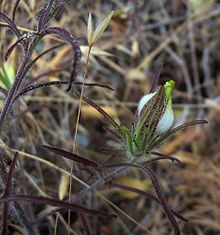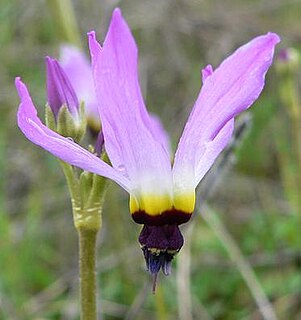
Primula clevelandii, with the common name of Padre's shooting star, is a species of primrose.
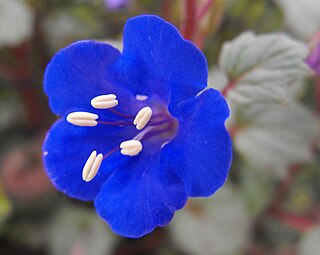
Phacelia campanularia is a species of flowering plant in the borage family, Boraginaceae, known by the common names desertbells, desert bluebells, California-bluebell, desert scorpionweed, and desert Canterbury bells. Its true native range is within the borders of California, in the Mojave and Sonoran Deserts, but it is commonly cultivated as an ornamental plant and it can be found growing elsewhere as an introduced species.

Cordylanthus is a genus of plants in the family Orobanchaceae native to western North America. They are known commonly as bird's beaks. Like other Orobanchaceae genera, bird's beaks are root parasites which insert haustoria into the roots of host plants to obtain nutrients. These are spare, weedy-looking annual plants with long branching erect stems and little foliage. Many bear bird's-beak-shaped flowers.

Castilleja rubicundula is a species of Indian paintbrush known by the common name cream sacs.

Chloropyron maritimum is a rare species of flowering plant in the family Orobanchaceae known by the common names salt marsh bird's beak and Point Reyes bird's beak, depending on the specific subspecies. It was formerly classified as Cordylanthus maritimus.

Cordylanthus tenuis is a species of flowering plant in the family Orobanchaceae known by the common name slender bird's beak. It is native to the US states of California, Oregon, and Nevada, where it grows in woodland and forest. It erects a spindly stem which may exceed a meter in height with sparse narrow leaves a few centimeters long, and is sometimes sticky with glandular secretions. The plant is greenish and tinted with yellow or purple coloration. The stem branches at intervals and at the end of each branch is a cluster of one to several flowers. Each pocket-shaped flower is one to two centimeters long and about one wide, made up of fuzzy maroon lobes with white or yellow lips.
Hulsea vestita is a species of flowering plant in the daisy family known by the common name pumice alpinegold.

Cordylanthus nidularius is a rare species of flowering plant in the family Orobanchaceae known by the common name Mt. Diablo bird's beak.
Cordylanthus orcuttianus is a rare species of flowering plant in the family Orobanchaceae known by the common name Orcutt's bird's beak. It is native to Baja California and southern San Diego County, California, where few populations are known. It is a plant of coastal scrub habitat. This annual herb grows to a maximum of half a meter in height and is green to reddish-green in color and coated in stiff hairs. The leaves are up to 8 centimeters long and dissected into narrow segments. The inflorescence is a very dense cluster of flowers surrounded by bracts which are divided into narrow segments like the leaves. Each flower is up to 2.5 centimeters long and is made up of a yellow-tipped white fibrous pouch enclosed by a calyx of sepals.

Chloropyron palmatum, formerly classified as Cordylanthus palmatus, is a rare species of flowering plant in the family Orobanchaceae. It is known by the common names of palmate salty bird's-beak and Palmate-bract bird's-beak.
Cordylanthus pilosus is a species of flowering plant in the family Orobanchaceae known by the common name hairy bird's beak. It is endemic to the mountain ranges and foothills of northern California, where it grows in woodland and chaparral habitat, often on serpentine soils. There are three subspecies, each mainly limited to a different section of mountains. In general this annual herb is erect and branching, reaching a maximum height anywhere between 20 centimeters and 1.2 meters. It is purple-tinted gray-green in color and usually quite hairy in texture, the hairs sometimes associated with sticky glands. The branches have sparse tufts of small linear leaves. The flowers of the inflorescence have bracts which may be linear in shape or lobed, each lobe knobby or notched. The flower is up to 2 centimeters long and has a whitish pouch marked with yellow and purple enclosed in hairy sepals.
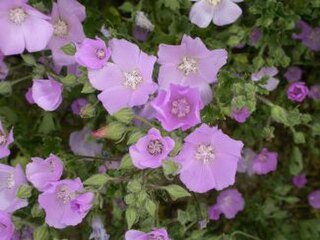
Eremalche parryi is a species of flowering plant in the mallow family known by the common name Parry's mallow.
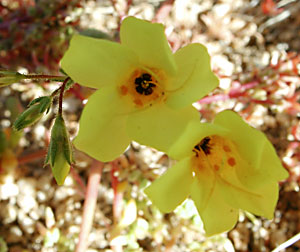
Leptosiphon aureus is a species of flowering plant in the phlox family known by the common name golden linanthus.

Leptosiphon nuttallii is a species of flowering plant in the phlox family known by the common name Nuttall's linanthus.
Monardella australis is a species of flowering plant in the mint family, known by the common name southern monardella.

Monardella hypoleuca is a species of flowering plant in the mint family, known by the common names thickleaf monardella and white leaf monardella.
Monardella linoides is a species of flowering plant in the mint family known by the common name flaxleaf monardella.

Sidalcea malviflora is a species of flowering plant in the mallow family, known by the common names dwarf checkerbloom, Greek mallow, prairie mallow and dwarf checkermallow.

Sidalcea oregana is a species of flowering plant in the mallow family known by the common name Oregon checkerbloom.

Physaria kingii is a species of flowering plant in the family Brassicaceae known by the common name King bladderpod. It is native to western North America from Utah to Baja California, where it grows in dry and rocky habitat, such as deserts and adjacent mountain slopes. This is a perennial herb growing a small, hairy stem from a caudex. The leaves form a patch or rosette around the caudex, each up to 6 centimeters long and round, oval, diamond, or spoonlike in shape. The inflorescence is an erect or mostly upright raceme of bright yellow mustardlike flowers. The fruit is a hairy capsule under a centimeter long suspended on a short, often curvy pedicel.
